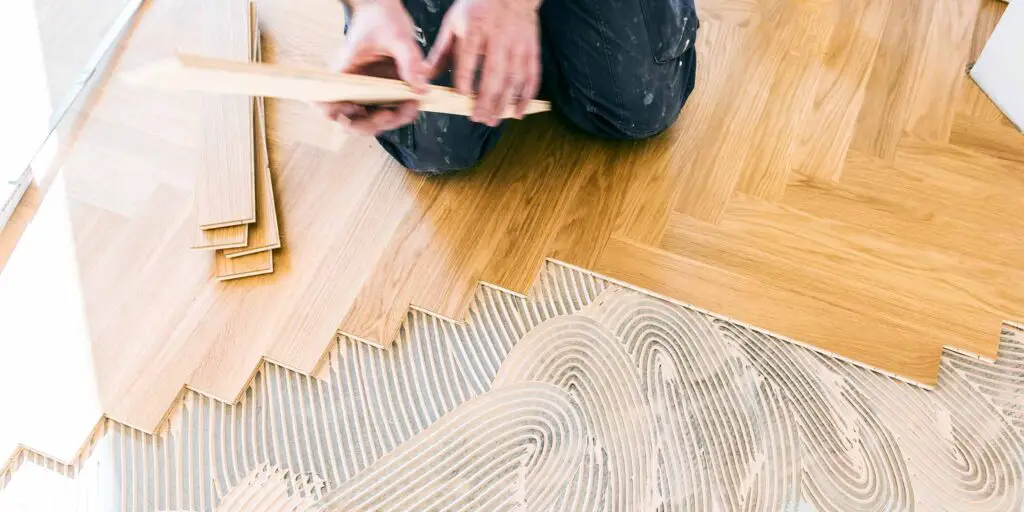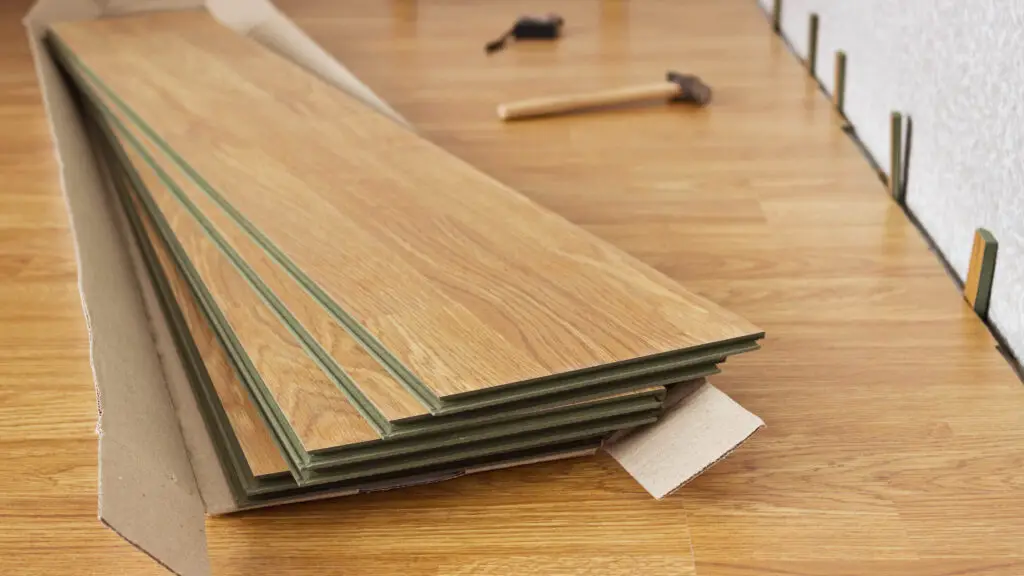When it comes to choosing the right flooring for your home or office, the decision between engineered wood and laminate can be a challenging one.
Both options have their unique properties, benefits, and drawbacks, each making them suitable for different needs and environments.
This article aims to provide a comprehensive comparison of engineered wood flooring versus laminate, helping you make an informed decision that best fits your specific requirements and aesthetics.
Engineered Wood Flooring

Description and Manufacturing Process
Engineered wood flooring is a popular choice for those seeking the warmth and timeless beauty of real wood. It is a hybrid product composed of multiple layers, with a core of high-quality plywood or high-density fiberboard and a top veneer layer of solid wood.
This veneer can range in thickness, with thicker layers allowing for more sanding and refinishing over the lifespan of the floor.
The manufacturing process typically involves binding these layers together under heat and high pressure.
This composite structure gives engineered wood its unique properties, combining the strength and stability of its core material with the attractive appearance of its natural wood surface.
Pros
- Durability: Engineered wood flooring is known for its durability and longevity. Its layered construction provides stability, reducing the likelihood of warping or buckling due to changes in humidity and temperature.
- Aesthetics: With its top layer of real wood, engineered flooring offers the authentic look and feel of solid wood, adding a touch of elegance and sophistication to any room.
- Resale Value: Homes with engineered wood floors may have a higher resale value. Many buyers appreciate the durability and high-end look of engineered wood.
Cons
- Cost: Engineered wood flooring tends to be more expensive than laminate. The price can vary widely depending on the type and quality of the wood used in the veneer layer.
- Maintenance Requirements: While engineered wood is more durable than solid wood, it still requires care. Regular sweeping or vacuuming is necessary to prevent dirt and grit from scratching the surface, and spills should be wiped up promptly to avoid staining. Depending on the thickness of the veneer layer, it can be sanded and refinished only a limited number of times.
- Environmental Impact: The manufacturing process of engineered wood can involve the use of chemicals and adhesives that may harm the environment. However, many manufacturers are now adopting greener practices to reduce this impact.
Laminate Flooring

Description and Manufacturing Process
Laminate flooring is a synthetic flooring product that simulates the appearance of hardwood with a photographic applique layer under a clear protective layer. Its core layer is usually composed of resin and fiberboard materials.
The manufacturing process involves fusing multiple layers under high pressure to create a robust and durable flooring material.
The top layer, known as the wear layer, is made of aluminum oxide or melamine resin, which provides superior resistance against scratches and fading.
Pros
- Affordability: One of the primary advantages of laminate flooring over engineered wood flooring is its cost-effectiveness. Laminate flooring is typically less expensive, making it an attractive option for those on a budget.
- Low Maintenance: Laminate flooring requires minimal maintenance. Regular sweeping and occasional mopping are typically sufficient to keep this type of flooring clean and looking its best.
- Scratch Resistance: Unlike engineered wood, laminate flooring is highly resistant to scratches and dents, making it an excellent choice for high-traffic areas or homes with pets.
Cons
- Aesthetic Appeal: While laminate flooring can mimic the look of real wood, it does not offer the same authentic feel or depth of color found in engineered wood flooring. This might be a drawback for those looking for a more high-end or natural look.
- Cannot Be Refinished: Laminate flooring does not hold up well to sanding or refinishing. Once it’s worn out, it can’t be restored like engineered wood flooring. Instead, it must be replaced altogether, which could factor into long-term costs and sustainability considerations.
Comparison
Durability: Engineered Wood vs. Laminate
When it comes to durability, both engineered wood and laminate flooring have their strengths and weaknesses.
Engineered Wood is constructed from real wood, which gives it a natural hardness and resilience. Its top veneer layer is made from genuine hardwood, while the layers beneath are high-quality plywood.
This multi-layered construction enhances its stability and reduces the likelihood of warping over time due to humidity or temperature changes.
However, engineered wood is susceptible to scratching and denting, especially in high-traffic areas, and can fade when exposed to direct sunlight over extended periods.
Laminate, on the other hand, scores high on scratch resistance and durability in high-traffic areas due to its tough top wear layer.
Its composition of resin and fiberboard materials also stands up well against moisture and humidity, making it a popular choice for kitchens and bathrooms.
However, once the upper layer of laminate gets damaged, it cannot be refinished or repaired; the entire plank must be replaced.
Engineered wood offers superior longevity, given its ability to be refinished multiple times. Laminate flooring, while less robust over the very long term, provides better resistance to scratches and daily wear in the short term.
The choice between the two often comes down to where the flooring will be installed, the expected traffic levels, and personal preference regarding maintenance and aesthetics.
Cost: Engineered Wood vs. Laminate
In terms of cost, there’s a noticeable difference between engineered wood and laminate flooring. Engineered wood tends to be more expensive due to its real wood composition and the complex manufacturing process it undergoes.
On average, the cost of engineered wood flooring ranges from $3 to $10 per square foot without installation, and it can go up to $20 per square foot for higher-end types.
Laminate flooring, made of composite wood pressed together and topped with a photograph of hardwood, is significantly less expensive.
It averages between $1 and $5 per square foot without installation, depending on the quality. If you’re budget-conscious, laminate flooring might be your preferred choice.
However, it’s worth noting that while engineered wood has a higher upfront cost, it could prove more cost-effective in the long run given its longevity and ability to withstand refinishing.
As with any home investment, it’s important to consider both the immediate and long-term financial implications.
Maintenance: Engineered Wood vs. Laminate
When it comes to maintenance, engineered wood, and laminate flooring present different considerations. Engineered wood, while able to withstand refinishing, requires more regular attention.
It recommends sweeping or vacuuming regularly to prevent dust and dirt from scratching the surface. Spills should be cleaned up promptly to avoid water damage.
Over time, engineered wood might require sanding and refinishing, a process that can be both time-consuming and costly.
On the other hand, laminate flooring boasts a higher resistance to stains, scratches, and daily wear, making it easier to maintain on a day-to-day basis. Routine care simply involves sweeping or dry mopping to keep it free of dirt and dust.
Unlike engineered wood, laminate flooring can handle water spills better, given its protective upper layer, although it’s still advisable to wipe up spills immediately.
However, because it can’t be refinished if a laminate floor gets severely damaged, the affected planks will need to be replaced.
Overall, if low maintenance is a priority, laminate flooring may be a more practical choice. However, for those willing to invest the time and resources into upkeep, engineered wood can offer a rich aesthetic and durability that may justify its maintenance needs.
Aesthetic Appeal: Engineered Wood vs. Laminate
The aesthetic appeal of your flooring significantly contributes to the overall ambiance of your home. Here is where engineered wood and laminate flooring truly diverge.
Engineered wood flooring not only mimics but is crafted from real wood. This gives it a natural and luxurious appearance that can elevate the look and feel of any room.
Available in a wide variety of species, grains, patterns, and finishes, engineered wood offers a range of customization that can complement any home decor style, from traditional to contemporary.
Over time, as the wood ages, it develops a rich patina that further enhances its beauty.
Laminate flooring, on the other hand, is manufactured from composite wood that has been pressed together and topped with a photograph of wood grain.
While modern manufacturing techniques have significantly improved the realism of laminate flooring, they may not fully replicate the depth and texture of real wood.
However, laminate flooring does offer an extensive selection of designs, including wood, stone, and tile effects, providing versatility for different stylistic preferences. It’s a suitable choice for those seeking a cost-effective, yet visually pleasing flooring option.
So, engineered wood flooring holds a slight edge in terms of aesthetic appeal due to its natural wood composition and the unique character it develops over time.
However, the choice between engineered wood and laminate should ultimately depend on personal preference, budget, and specific decor needs.
Related Topics:
Conclusion
In conclusion, both engineered wood and laminate flooring have their unique strengths and can enhance the aesthetic appeal of your home. Engineered wood, crafted from real wood, offers a luxurious and natural appearance, aging beautifully over time.
Conversely, laminate flooring provides a cost-effective and versatile option with a wide range of designs. Your choice should be guided by your personal taste, budget, and specific decor requirements.
For homeowners seeking a balance between cost and durability without compromising on the look, laminate flooring may be a more suitable choice.
However, if budget is less of a concern and you value the authentic, natural aesthetics of real wood, engineered wood flooring is recommended.
Based on overall factors such as durability, aesthetics, and value, engineered wood flooring slightly outshines laminate flooring.
FAQs
What is the primary difference between engineered wood flooring and laminate flooring?
The primary difference lies in their composition. Engineered wood flooring is made of real wood layers, with a top layer of hardwood, offering a luxurious and natural appearance. On the other hand, laminate flooring is synthetic, consisting of a photographic layer that imitates the look of wood, stone, or tile, backed by a core layer for stability.
Does engineered wood flooring or laminate flooring offer a better lifetime value?
Both types of flooring offer good lifetime value, but this can depend on factors like usage and maintenance. Engineered wood flooring, with proper care, can last for decades and even increase the value of your home due to its authentic wood construction. Laminate flooring, while not as durable as engineered wood, is less expensive upfront and can last up to 20 years with proper care.
Is it possible to refinish engineered wood flooring like you can with solid hardwood?
Yes, engineered wood flooring can be refinished, but the number of times it can be done depends on the thickness of the top veneer. Some high-quality engineered wood flooring can be sanded and refinished several times during its lifetime, giving it an edge in terms of longevity over laminate flooring, which cannot be refinished.


1 thought on “Guide On Engineered Wood Flooring VS Laminate”